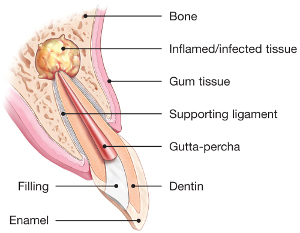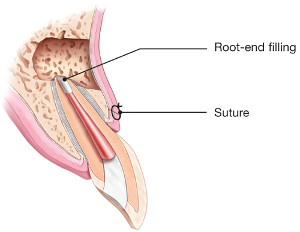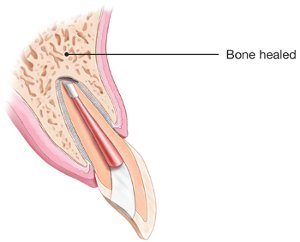What is Surgical Endodontic Treatment and Why would it be necessary?
Surgical Endodontic treatment is performed when inflammation or infection persists in the bony area around the end of the root after conventional Endodontic treatment. It is also sometimes recommended when there is no other way to access the area because of blockages in the canal, or when we need to visually inspect and treat the end of the root.
Benefits
- The tooth is retained, resulting in a more healthy oral condition.
- Eliminates the need for more expensive prosthetic (artificial) replacement.
- Can prevent Disassembly of existing restoration and need for remake of crowns or bridges.
Surgical Treatment
Surgical Endodontic treatment can be performed on any tooth as long as the tooth is periodontally sound (the gum condition is healthy) and restorable (there is enough remaining healthy tooth structure to warrant reconstruction of the tooth).
How Long Will it Take?
Treatment is generally performed in a single appointment of approximately 90 minutes.
Diagnosis/Pretreatment
Diagnostic procedures consist of multiple images or and/or cbCT imaging ( taken to better locate and visualize the roots), examination of the periodontal tissues and evaluation of suitability of the tooth for treatment. The existing restoration will be examined and alternatives to surgery will be explained in detail.

Figure 1
Maxillary (Upper) Incisor – Cross Section View
Surgical Access and Apicoectomy
With the use of modern anesthetics, endodontic surgery involves very little discomfort. An incision is made and the gum tissue is retracted. This allows for good visualization of the surgical area. Any inflamed or infected tissue is removed. If there is sufficient material, a specimen will be sent to laboratory for analysis (Biopsy). The tip of the root is then resected (removed). This is called an Apicoectomy.
Figure 2
Surgical Access and Apicoectomy

Sealing of the Apex
The end of the root is meticulously examined and a small cement filling(s) may be placed to seal the end of the root canal. A few stitches are placed in the gum to help the tissue heal properly.

Figure 3
Maxillary (Upper) Incisor – Cross Section View
Post Operative Instructions
In most situations, post-operative discomfort is minimal. Patients are given a specific set of instructions regarding surgical post-operative care. This mostly involves icing the area and mild analgesics. We generally recommend that you rest for remaining portion of the day. The stitches are removed within a few days.
Follow-Up Examination
Patients are recalled at 6 month intervals to examine for proper healing.
Figure 4
Healed Surgery.

Cost
The cost of endodontic surgery varies according to the severity of the problem, the location of the tooth and the number of fillings placed at the root end. Dr. Kaufmann recommends a consultation appointment in order to provide you with an estimate and detailed explanation.
Insurance plans generally cover surgical treatment to the same extent as conventional endodontics. As with any insurance plan, it is a good idea to have a preauthorization performed before the procedure.
Prognosis
The rate of success for surgical treatment varies with the tooth, position in the mouth, periodontal condition, previous treatment and other factors particular to the case. Dr. Kaufmann will address the prognosis during your consultation appointment.
Sometimes surgery exposes an impossible treatment situation. This is most often the case with Vertical Root Fractures or Split Tooth. Extraction is often necessary in that case.
Alternatives to Surgery
Extraction of the tooth and prosthetic (artificial) replacement is the usual alternative. Unfortunately, this can often be more expensive and difficult than surgical treatment. Even with bridgework or an implant, there is no true substitute for your own tooth. That is why surgery may be a better option in many cases.
After Your Surgery
You have just undergone an Endodontic Surgical procedure. By following these instructions you will assist the area in its recovery and prevent complications.
1
1. You will be asked to apply pressure to the surgical area with your hand for 5 minutes following the procedure. This will assist clotting and proper tissue adaptation. Apply steady but moderate pressure. You will be shown how to do this.
2
2. Under the surgical area, clots are now forming. These are important for proper healing. Do not rinse or spit today. Rinsing can dislodge the clot and result in bleeding. If necessary, wipe into a Kleenex as shown.
3
6. Several sutures have been placed to keep the incision closed. It is important that the area be left alone for 48 hrs to allow closure of the wound. Do not attempt to look at the area because this can cause stretching and tearing of the sutures. An appointment will be made in a few days to remove the stitches. Occasionally one or more of the stitches may fall out a few days after the surgery. This is normal.
7. The following day, brush other areas of the mouth normally. Do not brush in the surgical area until the stitches are removed. Instead, use a warm saline rinse made of a teaspoon of salt in a tall glass of warm water. Rinse gently, allowing the water to flow over the surgical area. Should you wish to use mouthwash instead, use heavy dilution with water since these solutions can burn the area if they are used straight out of the bottle.
(a) Eat relatively soft foods for the first day or so. Pasta, eggs, sandwiches, lukewarm soup, stew, salads and other similar foods are acceptable.
(b) Avoid hard or sharp foods such as chips, pretzels, crusty bread, crackers, granola bars etc.
(c) Dr. Kaufmann recommends cold foods (such as milkshakes) immediately after the procedure since these are soothing to the area and can be eaten with a straw.
9. You may be provided with instructions regarding medication to help with any discomfort. We suggest that you start on the medication before the freezing is gone. Most patients do very well with Ibuprofen alone or alternating with Tylenol extra strength. (Tylenol #3 (with Codeine) is rarely necessary.) If you are like most patients, you will only require Ibuprofen on the day of the procedure. The following day, you will have swelling but very minimal discomfort.
10. Smokers are urged to cease smoking until the sutures are removed. Nicotine has been shown to delay wound healing. Should you be unable to stop, try to cut down by at least half. Consumption of alcohol should be avoided.
Surgical procedures performed in this office have an extremely high rate of success. Your cooperation is important in obtaining the best possible result. Should you have any questions, please call Dr. Kaufmann at the regular office number (204) 783-2971. Dr. Kaufmann has a 24 hr answering service that is fully staffed at all times and will return your call as soon as possible.
